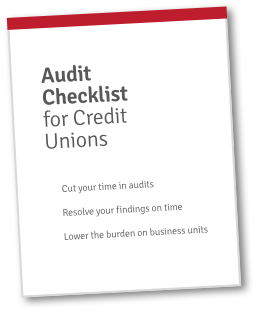Taking Part in Your Credit Union’s Next Audit? Read This.
If you are reading this, you may be new to the world of credit union audit processes. Audits are an essential part of the credit union’s operations and ensure that all internal controls are in place and functioning properly.
To help you better understand the ins and outs of audits and audit procedures, we will introduce a few key terms here. Some of this may be remedial, and some of it may give you more confidence in—and insight about—your role in your credit union’s audit.
If you’re no stranger to audits, give yourself a better leg up with our Credit Union Audit Checklist.
Internal auditing
Internal auditing is an independent, objective assurance and consulting activity designed to add value and improve an organization's operations. It helps an organization accomplish its objectives by bringing a systematic, disciplined approach to evaluate and improve the effectiveness of risk management, control, and governance processes. It also helps an organization to understand the effectiveness of its risk management processes and the reliability of financial reporting.
Supervisory committee (or audit committee)
An audit supervisory committee is the committee responsible for overseeing the internal audit function of an organization. Its primary purpose is to ensure that internal audit activities are conducted in accordance with established policies and procedures and that the internal audit function is providing the organization with an effective and independent review of its operations, financial performance, and compliance with applicable laws and regulations. The committee typically reviews the internal audit plan, monitors the progress of internal audit activities, and ensures that any recommendations are implemented.
Some credit unions have an audit committee instead of a supervisory committee. There is little difference between the two, but whereas supervisory committees are typically independent from the board of directors, an audit committee is made up of the board of directors.
Audit finding
An audit finding is a conclusion regarding an item that was examined during the course of an audit. An audit finding may reveal that an organization does not meet certain standards, or that an area of the organization needs to make changes to comply with regulations. Audit findings can also highlight areas of risk or areas that need attention.
Overdue, unresolved, and repeat findings
An unresolved finding is an issue or finding that was identified during an audit but was not addressed or resolved in a timely manner. It is a warning sign that there may be a problem that requires immediate attention. This can be the result of a lack of oversight, inadequate resources, or other factors that have caused the audit finding to remain unresolved.
Overdue findings are unresolved findings that remain unaddressed beyond the date by which they were scheduled to be finished.
Repeat findings are past issues that remain unresolved or reoccur in subsequent audits of the same type.
Internal controls
Internal controls are designed to help ensure accuracy and consistency in the reporting of financial information, detect and prevent fraud, and protect the credit union’s assets.
Risk assessment
Risk assessment is the process of identifying, analyzing, and assessing organizational risks—especially financial risks. Risk assessments help auditors plan the audit process, decide which tests to perform in the audit, and assess the sufficiency and appropriateness of evidence obtained.
Remediation
Remediation refers to the process of correcting any weaknesses that were identified during an audit. This can involve developing new policies and procedures to ensure compliance, making changes to existing processes, and implementing new controls to help prevent similar issues from occurring in the future.
Making Audits Easier
This internal audit terminology guide will get you only so far.
Maybe you work in one of the credit union’s business units and you want the audit process to be as simple and straightforward as possible.
Or maybe you’re on the audit team and you want to dramatically reduce the amount of administrative tasks required.
Redboard is an audit management solution that helps credit unions complete audits faster and more efficiently. If you would like to learn more, please request a short assessment—we’ll be the first to tell you if we don’t think Redboard can help.
In addition, credit unions must comply with various state and federal regulations, which can be complex. The internal audit team must ensure that the credit union is in compliance with those regulations through a comprehensive audit process. Finally, credit union internal audit teams must constantly keep up with changing regulations and industry trends in order to best serve the credit union.
Business units have a crucial role in a credit union’s internal audit as they are responsible for providing accurate and reliable information about the organization’s operations, financial performance, and compliance with applicable laws and regulations.
Business units provide auditors with the necessary data and information to assess the adequacy of internal controls and processes, identify potential risks, and ensure that the credit union is operating in a safe and sound manner. Additionally, business units should work with the internal audit team to ensure those audit recommendations are implemented in a timely manner.
In short, the audit team reviews how it all happens and makes recommendations for how it should happen. The leadership team creates policies based on the audit team’s recommendations. Finally, business units actually make it all happen—they’re responsible for implementing, carrying out, and reporting on the agreed-upon policies.


 Get FREE Access to the Audit Checklist for Credit Unions!
Get FREE Access to the Audit Checklist for Credit Unions!


